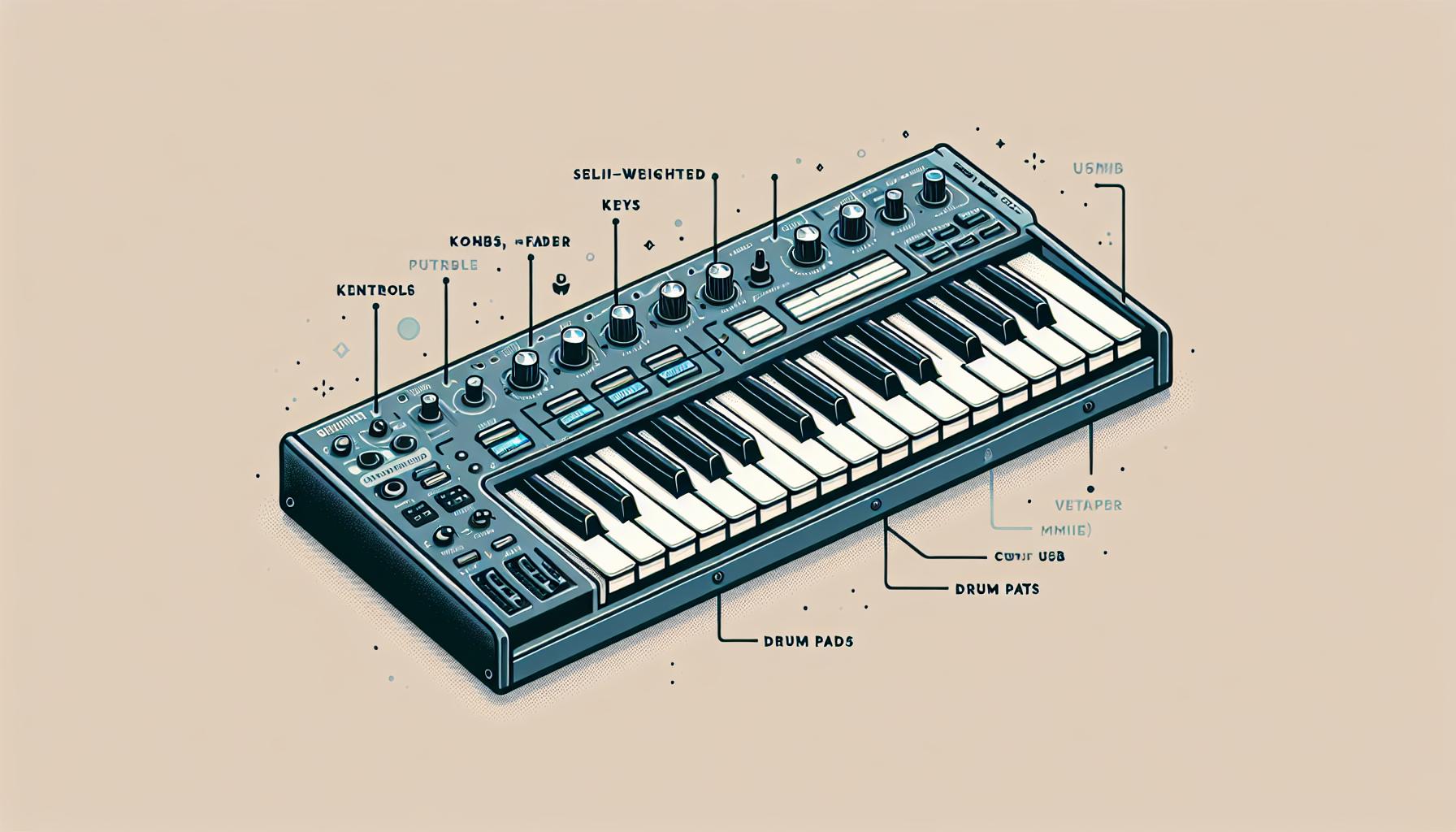Diving into the world of music production can be as thrilling as it is daunting for beginners. With a maze of equipment and software to navigate, finding the right tools to express your musical ideas is crucial. That's where a keyboard with MIDI capabilities comes in, offering a gateway to creating music that resonates with your soul.
A MIDI keyboard doesn't just play notes; it's a versatile tool that can control virtual instruments, trigger samples, and even adjust volume levels within your software. It's like having an entire orchestra at your fingertips, without needing a room full of instruments. For those just starting their journey in music production, this piece of equipment is a game-changer, making it easier to bring your melodies to life.
Understanding MIDI in Music Production
Musical Instrument Digital Interface, or MIDI, is a standard that allows electronic musical instruments, computers, and other equipment to communicate with each other. MIDI doesn't transmit audio; it sends information about how music is produced, including pitch, intensity, and rhythm. For beginners venturing into music production, grasping the essentials of MIDI can significantly enhance their creative expression and streamline their workflow.
At its core, MIDI is about control and communication. When a musician plays a note on a MIDI keyboard, it generates MIDI data, which can then trigger sounds from a computer or another device. This process transforms the MIDI keyboard into a powerful tool, capable of accessing a vast array of virtual instruments and effects. Beginners should understand that:
- MIDI is versatile. It's not just about notes on a keyboard; it can control drum patterns, chord progressions, and even lighting on stage.
- MIDI is non-destructive. Since it's transmitting data instead of audio, editing MIDI information allows one to change notes and rhythms without losing sound quality.
Selecting the right MIDI keyboard can feel overwhelming due to the plethora of options available. However, focusing on a few key features can simplify the decision-making process:
- Size and Portability: MIDI keyboards come in various sizes, from compact 25-key models to full 88-key instruments. Beginners might find smaller keyboards more manageable and less intimidating.
- Key Action and Touch Sensitivity: The feel of the keys is crucial. Weighted keys mimic the resistance of an acoustic piano, while synth-action keys are lighter, ideal for fast parts and glissandi.
- Extra Controls: Knobs, sliders, and pads on a MIDI keyboard offer additional ways to manipulate sound, providing a more immersive and interactive experience.
Despite the technical aspects of MIDI, it's essential to remember that at the heart of music production lies creativity. MIDI keyboards do not restrict but rather expand the palette of sounds and techniques at one's disposal. They act as a bridge between the tactile experience of playing an instrument and the digital world of music production.
For beginners, starting with a MIDI keyboard that aligns with their personal musical inclinations and production goals is advisable. Whether it's composing cinematic scores, crafting electronic beats, or recording live performances, a MIDI keyboard offers the flexibility to explore various genres and styles.
Why Choose a Keyboard with MIDI for Beginners?

Choosing the right tools for embarking on a musical journey is crucial for beginners. Among the plethora of options, a keyboard with MIDI functionality stands out as a particularly beneficial choice. This section delves into the reasons why beginners should consider starting their music production journey with a MIDI-equipped keyboard.
Firstly, ease of use is a paramount concern for beginners. MIDI keyboards are designed to be intuitive and user-friendly. They often come with software that guides users through the basics of music production, making the initial learning curve much less steep. These keyboards allow beginners to experiment with different sounds and styles without needing to master complex instruments or technology first. This experimentation is vital for fostering a love for music production and encouraging continued learning.
Additionally, affordability is a significant factor. When starting, the costs associated with music production can be daunting. Investing in a variety of instruments and equipment can quickly become expensive. MIDI keyboards offer a cost-effective solution, providing a wide range of sounds and functionalities in a single device. This multiplicity not only saves money but also space, making a MIDI keyboard an ideal choice for those working in small home studios or limited areas.
Another compelling reason to opt for a MIDI keyboard is its versatility. These keyboards serve as the cornerstone of any digital music production setup, allowing users to control various virtual instruments, synthesizers, and software. Whether one's musical interests lie in electronic, classical, rock, or any genre in between, a MIDI keyboard can emulate the sounds of countless instruments. This versatility ensures that beginners won't quickly outgrow their keyboard as their skills and interests evolve.
Moreover, MIDI keyboards foster creativity. With access to a broad spectrum of sounds and the ability to manipulate music in digital form, beginners can explore their creative boundaries freely. They can layer tracks, tweak sounds, and experiment with complex arrangements that would be challenging or impossible with traditional instruments alone. This creative freedom is essential for developing one's unique sound and style.
For those concerned about compatibility and future-proofing their setup, MIDI keyboards are a safe bet. The MIDI standard has been a staple in the music industry since the 1980s, ensuring that these keyboards can communicate with a vast array of equipment and software. This compatibility means that a MIDI keyboard purchased today will remain a valuable tool in a musician's arsenal for years to come, capable of adapting to new technologies and workflows.
Features to Look for in a Keyboard with MIDI

When venturing into the realm of music production, selecting the right MIDI keyboard can be a pivotal step for beginners. It's not just about having any keyboard: it's about finding the right fit that complements one's musical journey.
Key Count and Size
Firstly, the number of keys on a MIDI keyboard is critical. They typically range from 25 to 88 keys. Beginners might find a 49-key keyboard to be a sweet spot, offering enough range to play with two hands but not overwhelming in size.
- 25 keys are portable and great for simple melody lines.
- 49 keys balance playability with portability.
- 61 keys offer more range for complex compositions.
- 88 keys mimic a traditional piano, ideal for those with piano experience or who require the full range.
Weighted vs. Unweighted Keys
The feel of the keys is another aspect to consider. Weighted keys mimic the resistance of a traditional piano, which may be beneficial for those aiming to build transferrable skills. Unweighted keys, however, might be easier for beginners to handle and are typically found on smaller, more portable models.
Connectivity Options
MIDI keyboards should offer several connectivity options to ensure they can easily fit into any setup. USB connectivity is standard, but additional ports like MIDI Out/In, sustain pedal inputs, and sometimes even Bluetooth can greatly expand their versatility.
Control Features
Control features such as knobs, faders, and pads can drastically enhance a MIDI keyboard's functionality. They allow users to tweak sounds, control volume, and even trigger samples without touching a computer. For beginners, these can introduce a hands-on aspect to music production that's both educational and fun.
- Knobs can manipulate effects parameters.
- Faders offer precise control over volume levels.
- Pads are perfect for triggering drums or samples.
Software Compatibility
Finally, the software compatibility of a MIDI keyboard is paramount. Most brands bundle their keyboards with compatible music production software, which might range from introductory versions to more comprehensive suites. Checking that a keyboard works seamlessly with one's chosen DAW (Digital Audio Workstation) avoids potential headaches down the line.
Tips for Using a MIDI Keyboard Effectively

When diving into the world of music production, understanding how to use a MIDI keyboard effectively can make a significant difference. For beginners, it might seem daunting at first, but with a few tips, they'll be creating melodies like a pro in no time.
Start Simple
One of the first pieces of advice for beginners is to start simple. It's easy to get overwhelmed by the plethora of features and controls available on a MIDI keyboard. Beginners should focus on learning the basics of playing and recording before diving into the more complex functions. Mastery of simple chords and melodies can profoundly impact the quality of production. As they become more comfortable, gradually integrating new features and controls can help expand their creative palette without overwhelming them.
Utilize Software Tutorials
Most MIDI keyboards come with software instruments and recording software. These programs often include tutorials that are specifically designed to help new users get the most out of their MIDI keyboard. Beginners should take advantage of these resources. Understanding how to navigate the Digital Audio Workstation (DAW) they're using can significantly speed up the learning process. Learning about software compatibility early on ensures a smoother experience as they progress.
Explore the Range of Controls
MIDI keyboards are equipped with a variety of controls including knobs, faders, and pads which can enhance the music creation process. Exploring these can unlock new textures and sounds. They allow for real-time adjustments to effects, volumes, and other parameters which can add dynamism to music tracks. Practicing with these controls can help beginners understand the nuances of sound shaping and sequencing.
Practice Regularly
Like any musical instrument, proficiency comes with practice. Setting aside time each day to experiment with the MIDI keyboard can help beginners familiarize themselves with its layout and capabilities. Regular practice aids in muscle memory, making it easier to play more complex pieces over time. Additionally, experimenting with different styles of music can broaden their understanding and use of the keyboard.
Experiment With Different Sounds
One of the most exciting aspects of using a MIDI keyboard is the vast array of sounds it can produce. Beginners shouldn't shy away from exploring different instrument sounds and effects. This exploration can inspire new music and help them discover their unique style. Whether it’s the grandeur of a piano or the grit of a synthesizer, experimenting with sounds can be incredibly rewarding.
Conclusion
Embarking on the journey of music production with a MIDI keyboard opens up a world of creative possibilities. By keeping it simple at the start and leaning into the wealth of resources available, beginners can gradually build their skills. Regular practice and a willingness to experiment are key to unlocking the full potential of this versatile instrument. So go ahead, dive into the exploration of sounds and controls, and let your musical ideas flow freely. With patience and persistence, the MIDI keyboard will become an invaluable tool in your music production arsenal.
Harlan Kilstein began playing piano during covid with no piano background at all. He taught himself how to play learning what to do and what not to do.
Today he's an advanced intermediate player and can help you grow in your skills because he learned all this on his own.








